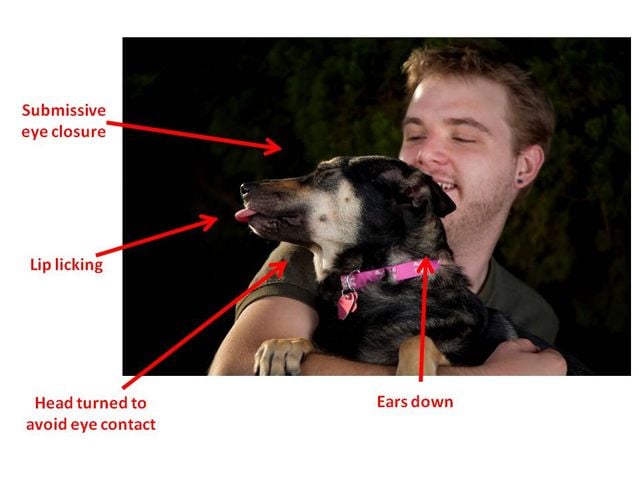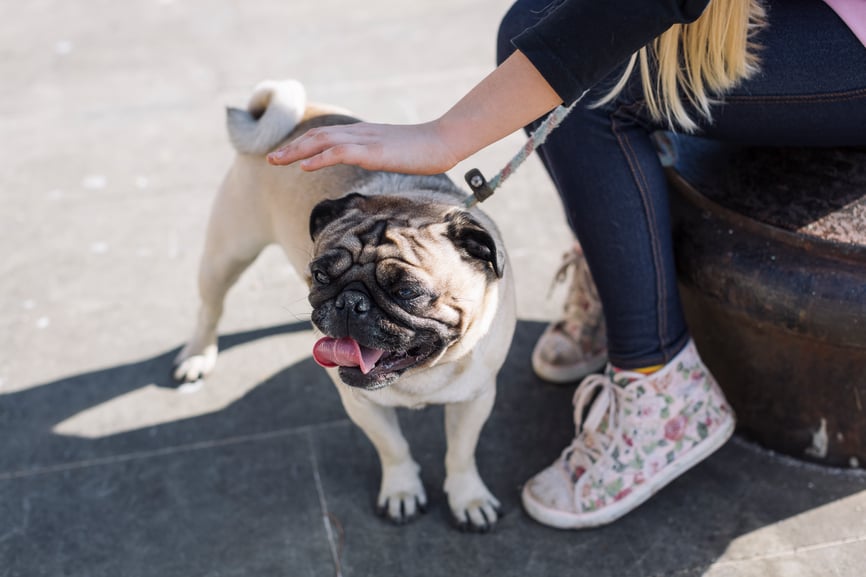I’m always saying this and it’s never not true: dogs are not humans. Yes, I know, it’s incredibly easy to forget this fact. I mean, it’s not that we forget they’re dogs, but we constantly forget that our body language and behaviors can have an entirely different meaning in canine language.
Fortunately, you can learn to “speak dog.” A good starting place is to understand what we do that makes our dogs feel anxious. In particular, you’ll communicate the right message by staying clear of these actions that make dogs nervous.
Staring
A frightened animal can be unpredictable. If they feel threatened enough, they will instinctively choose to flee the situation or to defend themselves by fighting. Unfortunately, in our human-centric world, you are most likely to meet a frightened dog while he is tethered via leash to a person or object.
A calming signal communicates to the dog that you are no threat.
Staring him down—looking directly in his eyes—is likely to be perceived as a challenge. If the dog can’t flee…well, you get the picture. Instead, lower your body to the dog’s level and look away from him.
This is what’s known as a “calming signal,” which communicates to the dog that you are no threat.
Hugging
Yes, I know this one is a bitter pill to swallow, but the evidence is hard to dispute. A 2016 study conducted by Dr. Stanley Coren concluded that 82% of dogs displayed signs of stress when hugged. Only 8% of the dogs in the study suggested in any way that they enjoyed the hug: this was determined by looking at the visual cues dogs displayed in dog hug photos.

Via Psychology Today
While some have questioned this study’s methodology, it does raise a good point: hugging might be seem affectionate to us, but it’s not necessarily perceived that way by dogs.A hug restrains a dog and can make them feel trapped.
If you want to give some love, try a gentle scratch on the hindquarters instead.
Also, it’s never a good idea to a hug a dog you don’t know. Frankly, this isn’t necessarily a dog-only convention: you’d feel trapped and uncomfortable, too, if a stranger walked up to you and held you in a tight bear-hug! If you want to give some love, try a gentle scratch on the hindquarters instead.
Petting on the Head
When we greet a new dog, our first inclination is to reach out to say hello. But reaching out your hand over a dog’s head is scary for most.
Instead of reaching over them in an intimidating gesture, reach along the side of the body or give a little scratch on the chest.

Yelling
Dogs are very sensitive to human tone of voice; it doesn’t take a lot to effectively communicate that you are unhappy with their actions.
This means that yelling or even raising your voice at your dog is not only unnecessary, but it can have unintended negative outcomes.
For example, a puppy that is yelled at for having an accident on the rug may look for a time when you aren’t around to have their next accident. Keep your voice calm and, if you need to verbally communicate that you are upset, simply use a firm tone. Never use physical punishment to punish your dog.
Erratic and Unpredictable Movement
Dogs like us to be predictable and, when our typical behavior changes, it can be scary.
I once knew a dog who would go crazy barking at a friend any time she’d been drinking because her walk changed and her speech became louder.
The same problem (erratic movement, not alcohol) can make hanging out around young children who run and tumble and yell nerve-wracking for some dogs. In these types of situations, be sure your dog has a place they can retreat to that is safe, quiet and private.
